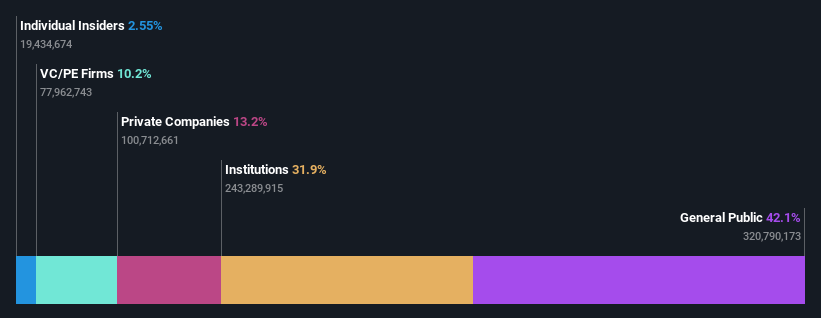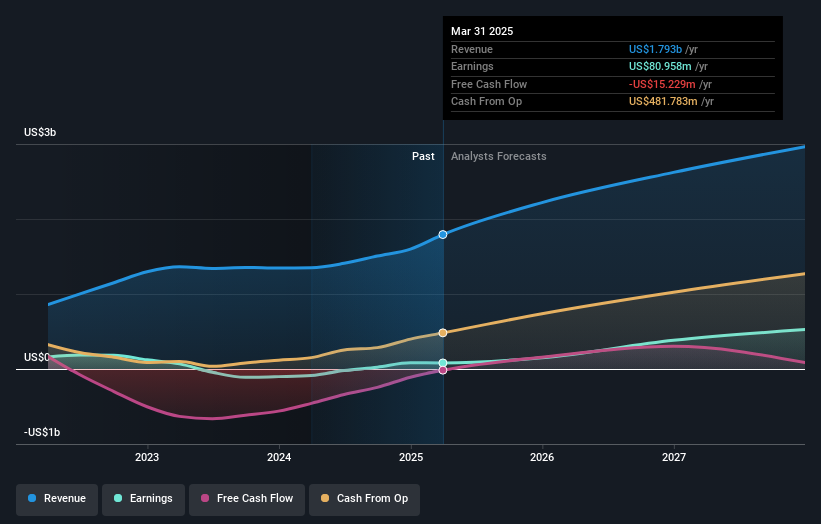- Canada
- /
- Metals and Mining
- /
- TSX:CS
While institutions invested in Capstone Copper Corp. (TSE:CS) benefited from last week's 12% gain, retail investors stood to gain the most
Key Insights
- Significant control over Capstone Copper by retail investors implies that the general public has more power to influence management and governance-related decisions
- The top 23 shareholders own 50% of the company
- Recent sales by insiders
To get a sense of who is truly in control of Capstone Copper Corp. (TSE:CS), it is important to understand the ownership structure of the business. The group holding the most number of shares in the company, around 42% to be precise, is retail investors. Put another way, the group faces the maximum upside potential (or downside risk).
Retail investors gained the most after market cap touched CA$5.5b last week, while institutions who own 32% also benefitted.
In the chart below, we zoom in on the different ownership groups of Capstone Copper.
Check out our latest analysis for Capstone Copper

What Does The Institutional Ownership Tell Us About Capstone Copper?
Institutions typically measure themselves against a benchmark when reporting to their own investors, so they often become more enthusiastic about a stock once it's included in a major index. We would expect most companies to have some institutions on the register, especially if they are growing.
As you can see, institutional investors have a fair amount of stake in Capstone Copper. This suggests some credibility amongst professional investors. But we can't rely on that fact alone since institutions make bad investments sometimes, just like everyone does. If multiple institutions change their view on a stock at the same time, you could see the share price drop fast. It's therefore worth looking at Capstone Copper's earnings history below. Of course, the future is what really matters.

We note that hedge funds don't have a meaningful investment in Capstone Copper. Hadrian Capital Partners Inc. is currently the company's largest shareholder with 13% of shares outstanding. For context, the second largest shareholder holds about 10% of the shares outstanding, followed by an ownership of 2.8% by the third-largest shareholder.
After doing some more digging, we found that the top 23 have the combined ownership of 50% in the company, suggesting that no single shareholder has significant control over the company.
While it makes sense to study institutional ownership data for a company, it also makes sense to study analyst sentiments to know which way the wind is blowing. Quite a few analysts cover the stock, so you could look into forecast growth quite easily.
Insider Ownership Of Capstone Copper
The definition of an insider can differ slightly between different countries, but members of the board of directors always count. Management ultimately answers to the board. However, it is not uncommon for managers to be executive board members, especially if they are a founder or the CEO.
I generally consider insider ownership to be a good thing. However, on some occasions it makes it more difficult for other shareholders to hold the board accountable for decisions.
Shareholders would probably be interested to learn that insiders own shares in Capstone Copper Corp.. It is a pretty big company, so it is generally a positive to see some potentially meaningful alignment. In this case, they own around CA$141m worth of shares (at current prices). If you would like to explore the question of insider alignment, you can click here to see if insiders have been buying or selling.
General Public Ownership
The general public-- including retail investors -- own 42% stake in the company, and hence can't easily be ignored. While this group can't necessarily call the shots, it can certainly have a real influence on how the company is run.
Private Equity Ownership
With an ownership of 10%, private equity firms are in a position to play a role in shaping corporate strategy with a focus on value creation. Sometimes we see private equity stick around for the long term, but generally speaking they have a shorter investment horizon and -- as the name suggests -- don't invest in public companies much. After some time they may look to sell and redeploy capital elsewhere.
Private Company Ownership
It seems that Private Companies own 13%, of the Capstone Copper stock. It's hard to draw any conclusions from this fact alone, so its worth looking into who owns those private companies. Sometimes insiders or other related parties have an interest in shares in a public company through a separate private company.
Next Steps:
It's always worth thinking about the different groups who own shares in a company. But to understand Capstone Copper better, we need to consider many other factors. Be aware that Capstone Copper is showing 1 warning sign in our investment analysis , you should know about...
If you are like me, you may want to think about whether this company will grow or shrink. Luckily, you can check this free report showing analyst forecasts for its future.
NB: Figures in this article are calculated using data from the last twelve months, which refer to the 12-month period ending on the last date of the month the financial statement is dated. This may not be consistent with full year annual report figures.
New: AI Stock Screener & Alerts
Our new AI Stock Screener scans the market every day to uncover opportunities.
• Dividend Powerhouses (3%+ Yield)
• Undervalued Small Caps with Insider Buying
• High growth Tech and AI Companies
Or build your own from over 50 metrics.
Have feedback on this article? Concerned about the content? Get in touch with us directly. Alternatively, email editorial-team (at) simplywallst.com.
This article by Simply Wall St is general in nature. We provide commentary based on historical data and analyst forecasts only using an unbiased methodology and our articles are not intended to be financial advice. It does not constitute a recommendation to buy or sell any stock, and does not take account of your objectives, or your financial situation. We aim to bring you long-term focused analysis driven by fundamental data. Note that our analysis may not factor in the latest price-sensitive company announcements or qualitative material. Simply Wall St has no position in any stocks mentioned.
About TSX:CS
Capstone Copper
A copper mining company, mines, explores for, and develops mineral properties in the United States, Chile, and Mexico.
Solid track record and good value.
Similar Companies
Market Insights
Community Narratives




